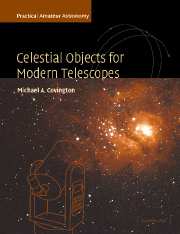Book contents
- Frontmatter
- Contents
- Preface
- Part I Amateur astronomy
- 1 Using this book effectively
- 2 Observing sites and conditions
- 3 The Moon, the Sun, and eclipses
- 4 The planets
- 5 Comets, asteroids (minor planets), and artificial satellites
- 6 Constellations
- 7 Stars – identification, nomenclature, and maps
- 8 Stars – physical properties
- 9 Double and multiple stars
- 10 Variable stars
- 11 Clusters, nebulae, and galaxies
- Part II 200 interesting stars and deep-sky objects
- Appendices
- Index
1 - Using this book effectively
Published online by Cambridge University Press: 22 September 2009
- Frontmatter
- Contents
- Preface
- Part I Amateur astronomy
- 1 Using this book effectively
- 2 Observing sites and conditions
- 3 The Moon, the Sun, and eclipses
- 4 The planets
- 5 Comets, asteroids (minor planets), and artificial satellites
- 6 Constellations
- 7 Stars – identification, nomenclature, and maps
- 8 Stars – physical properties
- 9 Double and multiple stars
- 10 Variable stars
- 11 Clusters, nebulae, and galaxies
- Part II 200 interesting stars and deep-sky objects
- Appendices
- Index
Summary
Amateur astronomy for a new generation
This is a handbook for the modern amateur astronomer. As far as possible, I've tried to write the book that I'd like to have in my own hands while at the telescope – along with a star atlas and the Handbook of the B.A.A., of course.
Amateur astronomy isn't what it used to be. A generation ago, most serious amateurs observed from their homes with large Newtonians; one star atlas and two or three reference books were the amateur's complete guide to the sky; the latest news, arriving by magazine, was two months old; and most of the stars visible in the telescope were absent from even the largest catalogues and atlases.
Those days are gone, thank goodness. Telescopes have changed – they are nearly all portable, and compact designs such as the Schmidt–Cassegrain are popular. As often as not, the telescope is computer-controlled.
More importantly, computers have brought high-quality data sources within the amateur's reach. Alongside star atlases, we use software that plots the star positions measured by the Hipparcos satellite. We can compute the positions of comets, asteroids, and artificial satellites at the touch of a button. We can even track clouds by satellite to see if we're going to have clear weather.
Accordingly, a major theme of this book is the effective use of astronomical data, especially the Internet. Web addresses are given throughout, as well as detailed information about classic and modern catalogues of celestial objects.
- Type
- Chapter
- Information
- Celestial Objects for Modern TelescopesPractical Amateur Astronomy Volume 2, pp. 3 - 5Publisher: Cambridge University PressPrint publication year: 2002

